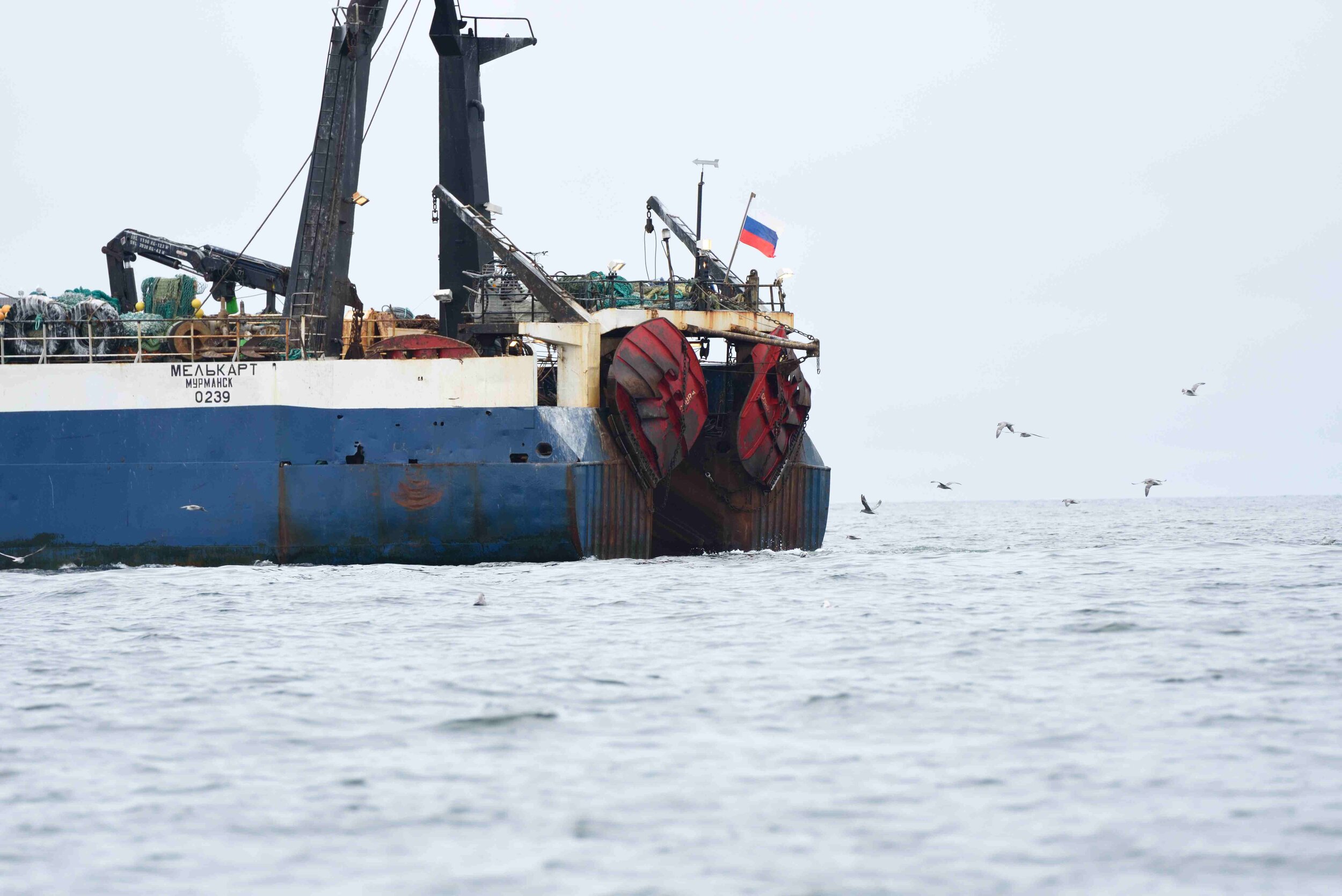Seven ways fishing trawlers aren’t great for the seabed
I’m writing this in the high Arctic at 78º North Latitude in early July, aboard Greenpeace’s Arctic Sunrise where I’m a guest for a few days, with 24-hour daylight and gleaming glaciers in the valleys of snow-capped coastal mountains. We’re here because shrinking sea ice and warming ocean water is moving fish farther north, and fishing vessels are coming with them.
These are big trawling ships, and in other regions trawl-fishing has harmed—in some cases ruined—vast areas of seafloor. Here there’s still a chance to get it right by letting trawlers work in some areas and designating other areas as trawl-free zones. We’re here to document the trawling and help advance the discussion.
Trawling ship. Photo: Carl Safina
Trawling at its most basic it’s a boat pulling a net through the water. Sometimes that net is midway between surface and seafloor. Sometimes—most of the time, actually—it’s dragged across the seafloor. Trawls have been called “bulldozers of the ocean.”
Recently some big retailers like McDonald’s and the major fishing companies of Norway and Russia have entered into an agreement with Greenpeace to not expand further until an agreement can be reached to put some big areas here aside, safe from trawling.
Trawling is one of the most basic and most effective ways of catching sea life. That’s good if you’re trying to catch sea life. If you’ve eaten fish, most were probably caught by trawling. Some of the most familiar fish like cod and flounder are caught mostly by trawling. Calamari?—trawling, mostly. Had a fish sandwich at a fast-food mega-franchise?—trawling. So if you’re in the fishing biz or enjoy your Fish-wich, trawling’s been part of your life. And not just seafood; the feed fed to farmed animals including farmed fish usually contains a lot of trawler-caught fish-meal. So most chickens and pigs and farmed salmon and shrimp are raised partly on ocean fish caught by trawling.
Here are some major issues:
1. Overfishing. Millions of tons of sea life find themselves engulfed in trawl nets each year. Trawling has been done so intensively that it’s depleted many kinds of fish in many parts of the world. Catches must be strictly managed or in a few years there’ll be little left.
2. Untargeted, unwanted catch, or “bycatch.” Regardless of different variations in method, the one thing all trawlers have in common is that they basically core a hole through the ocean, so they catch a lot of things they’re not trying to catch—unmarketable fish, marine mammals, even seabirds. In some fisheries the catch is pretty “clean.” But in many, more than half of what trawls catch is unwanted. Virtually all of a trawl’s catch comes up dead or fatally injured, and if it’s unwanted it’s just shoveled back. Shrimp fishing can be some of the worst, because small mesh also catches small fish. And large fish. At times, they can catch 10 fish for each single shrimp. Many are babies of large species, and have no market. Out come the shovels. I’ve seen it many times.
3. Destabilization of the seafloor. If the net is dragged, it is weighted. It plows heavily along the seafloor. Most of the deeper ocean seafloor has extremely stable natural conditions. Stable currents, stable temperature (it’s cold; things grow slowly). Not much happens to disturb the peace. Enter: disturbance—trawlers.
Heavy plates used to weight drag nets. Photo: Carl Safina
4. Corals. Corals aren’t just for tropical reefs. Many coral species have specialized to grow in deep, cold water. Those corals often continue growing for centuries (I’ve read that they can be thousands of years old)—until the moment a trawl snaps and crushes them. Off Florida and New Zealand, deep corals have been 97-99 percent destroyed by trawling (Allsopp et al. State of the World’s Oceans, 2009, Springer). This is where fish live and hide; it’s their habitat. These deep reefs and coral groves are among the oldest old-growth on Earth. And there are many kinds of soft corals too. That word “soft” can help you guess what happens when a heavy trawl net comes plowing through.
5. Anemones, sponges, sea pens, urchins, and other fine, fragile-bodied animals. A lot of the seafloor harbors delicate upstanding creatures. Woe unto them; they shall be felled.
6. Within the seafloor. Trillions of shelled or soft-bodied animals like worms, amphipods, clams, crabs, lobsters, and many others live in the seafloor in their quiet burrows, minding their own business and hiding. Quite crushable. This fauna is also food for fish and crabs. So even if you don’t care, even if you just want to catch or eat fish—if your method of catching fish kills the food of fish and ruins the places where fish live and hide, there won’t be as many fish to catch. In that sense, trawling can be like sawing off the tree-limb you’re standing on. So where trawlers trawl and what trawlers do makes a big difference to our ocean and our food supply. That’s why we need trawling-free areas.
7. Justice for all. Shocking perhaps, but the world wasn’t made just for those of us who happen to be here right now. The world was here and doing just fine for millions of years before we showed up. These trawling ships have been around for just a few decades. There are many people alive who were alive when the first big trawlers went to sea. And there will be many people alive in the future who will get what we leave and won’t get what we ruin. We can take care of the place, or we can wreck it. It’s really a deeply moral consideration. But there’s nothing that says the world owes us all the fish in the sea. Leaving some space in the sea is the smart—and the decent—thing to do.
Fragile seafloor of Svalbard. Photo: Carl Safina


